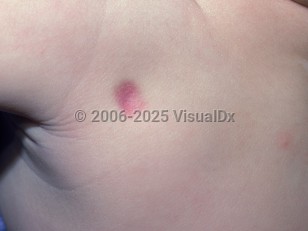Iatrogenic injury apparent in the newborn may be due to procedures performed in utero. Amniocentesis is the most common technique used to diagnose genetic disorders prenatally. The incidence of complications is very low but can include depressed, dimple-like lesions that are generally less than 5 mm in diameter but can be as large as 12 mm. Linear lesions have also been described. The most common locations are the extremities, followed by the head, neck, and chest. Although these injuries happen in utero, they are often not noted for several weeks to months after birth.
Intrauterine fetal heart rate monitoring via a spiral electrode can result in minor lacerations, ulcerations, scalp abscesses, and very rarely, herpetic infections. Scalp abscesses are erythematous, indurated masses that can be fluctuant. They can present at birth or as late as 3 weeks. Lymphadenopathy may be present. The abscesses are usually polymicrobial.
Medical procedure injury in utero
Alerts and Notices
Important News & Links
Synopsis

Codes
ICD10CM:
P00.7 – Newborn (suspected to be) affected by other medical procedures on mother, not elsewhere classified
SNOMEDCT:
1004018000 – Neonatal disorder due to and following operative procedure on mother
P00.7 – Newborn (suspected to be) affected by other medical procedures on mother, not elsewhere classified
SNOMEDCT:
1004018000 – Neonatal disorder due to and following operative procedure on mother
Look For
Subscription Required
Diagnostic Pearls
Subscription Required
Differential Diagnosis & Pitfalls

To perform a comparison, select diagnoses from the classic differential
Subscription Required
Best Tests
Subscription Required
Management Pearls
Subscription Required
Therapy
Subscription Required
References
Subscription Required
Last Updated:12/15/2021
Medical procedure injury in utero

